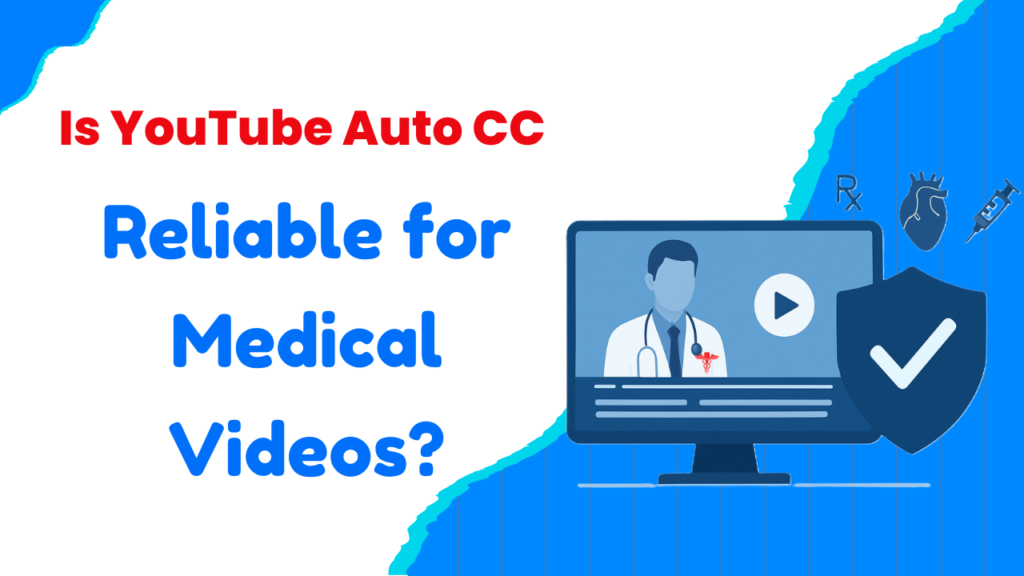
YouTube’s auto-generated closed captions (CC) feature has become a cornerstone of accessibility, allowing users to follow along with videos even in noisy environments or when sound isn’t an option. But when it comes to technical and life-critical content—such as medical videos—how reliable is this tool? https://youtu.be/eYuem2lT_hM Real-World Test: Analyzing a Medical Clip We recently tested YouTube auto CC on a video discussing several complex medical topics, including: Abdominal Aortic Aneurysm Pyloric Surgery Anticoagulation in Venous Thromboembolism Here are some examples of the auto-generated captions: “An abdominal aotic aneurysm is a surgical emergency…” “…the riskation an incision is made in the smooth muscle…” “…allow food to pass from the stomach to the geodum…” “…options for longerterm anticoagulation in venus thrombolism are a doac warin…” The Problems We Found Issue Type Caption Error Medical Accuracy Impact Misspelled Terms “aotic” instead of “aortic” Can mislead diagnosis Invented Words “riskation” (not a real word) Confuses learners Drug Name Confusion “doac warin” instead of “DOAC or warfarin” Dangerous miscommunication Anatomical Inaccuracy “geodum” instead of “duodenum” Misunderstanding procedures Why This Matters Medical terminology is precise by necessity. Inaccurate transcriptions can: Lead to misunderstandings Harm student learning Undermine credibility Create potential risks if misapplied When Can You Trust YouTube CC? Use Case Trust Level Casual or entertainment videos  Good Conversational content
Good Conversational content  Okay Educational or medical content
Okay Educational or medical content  Not reliable without review What Should You Do Instead? If you’re creating or consuming medical content: Use manually uploaded captions Employ AI tools like Whisper trained with medical vocabularies Always review or cross-verify subtitles Why MedXcribe Closed Captions? MedXcribe Closed Captions are specifically engineered for the medical field, providing unmatched accuracy and clarity. While most auto-captioning tools struggle with specialized terminology, MedXcribe ensures every spoken word, sound, and clinical detail is captured with precision. Here’s what sets it apart: Precision: Captures accurate medical terminology, including complex drug names, procedures, and anatomy. Context-Awareness: Understands medical conversations and distinguishes speakers, preserving the clinical narrative. Clarity: Delivers clean, readable captions with proper formatting and punctuation. Compliance-Ready: Developed with strict attention to patient confidentiality and medical data privacy. MedXcribe captions are expertly refined by professionals and tailored for lectures, consultations, surgeries, and educational videos. By using MedXcribe, your content becomes more inclusive, meets accessibility standards, and reaches a broader audience—all without compromising on medical accuracy. Conclusion While YouTube’s auto CC feature is a valuable accessibility tool, it falls short when applied to medical content. The risk of misinterpreting critical terms, medications, or procedures makes it unsuitable for educational or professional healthcare use without thorough review. For students, educators, and healthcare professionals, accuracy is non-negotiable. Always choose videos from credible medical sources and verify whether captions are manually curated or auto-generated. When in doubt, don’t rely on them for essential learning.
Not reliable without review What Should You Do Instead? If you’re creating or consuming medical content: Use manually uploaded captions Employ AI tools like Whisper trained with medical vocabularies Always review or cross-verify subtitles Why MedXcribe Closed Captions? MedXcribe Closed Captions are specifically engineered for the medical field, providing unmatched accuracy and clarity. While most auto-captioning tools struggle with specialized terminology, MedXcribe ensures every spoken word, sound, and clinical detail is captured with precision. Here’s what sets it apart: Precision: Captures accurate medical terminology, including complex drug names, procedures, and anatomy. Context-Awareness: Understands medical conversations and distinguishes speakers, preserving the clinical narrative. Clarity: Delivers clean, readable captions with proper formatting and punctuation. Compliance-Ready: Developed with strict attention to patient confidentiality and medical data privacy. MedXcribe captions are expertly refined by professionals and tailored for lectures, consultations, surgeries, and educational videos. By using MedXcribe, your content becomes more inclusive, meets accessibility standards, and reaches a broader audience—all without compromising on medical accuracy. Conclusion While YouTube’s auto CC feature is a valuable accessibility tool, it falls short when applied to medical content. The risk of misinterpreting critical terms, medications, or procedures makes it unsuitable for educational or professional healthcare use without thorough review. For students, educators, and healthcare professionals, accuracy is non-negotiable. Always choose videos from credible medical sources and verify whether captions are manually curated or auto-generated. When in doubt, don’t rely on them for essential learning.




